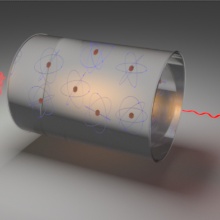Future quantum networks will need flying qubits and stationary nodes. As for the generation of single photons which may act as flying qubits, resonantly excited single-semiconductor quantum dots are ideal in terms of their on-demand single-photon emission, indistinguishability, and brightness. Atomic systems can effectively act as mediators for photon–photon interactions, storage media, or building blocks for stationary qubits. Here, we hybridize these two systems and investigate the non-classical interference of spectral Lorentzian-shaped photons, fine-tuned between the cesium (Cs)-D1 hyperfine resonances. The temporal delay in the dispersive hot atomic cesium vapor amounts up to 50 times the photons’ initial width and reveals beats on the single quanta. The photons’ indistinguishability is preserved even after atomic-enabled delay. This proves that the interaction with the Cs vapor conserves the photons’ coherence. The role of spectral diffusion in the solid-state emitter is studied in single- and two-photon experiments in light of the strong frequency dependence of the atomic medium. Our results pave the way for efficient hybrid interfaces between quantum dots and hot atomic vapors as storage media in future quantum networks.
Publication: Two-photon interference in an atom–quantum dot hybrid system
H. Vural S. L. Portalupi, J. Maisch, S. Kern, J. H. Weber, M. Jetter, J. Wrachtrup, R. Löw, I. Gerhardt, and P. Michler ![]() Optica 5, 367-373 (2018)
Optica 5, 367-373 (2018)
Contact person: H. Vural


